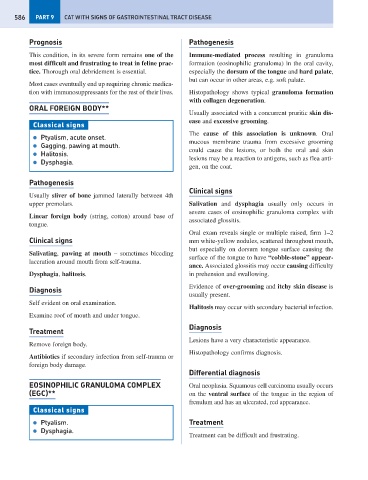Page 594 - Problem-Based Feline Medicine
P. 594
586 PART 9 CAT WITH SIGNS OF GASTROINTESTINAL TRACT DISEASE
Prognosis Pathogenesis
This condition, in its severe form remains one of the Immune-mediated process resulting in granuloma
most difficult and frustrating to treat in feline prac- formation (eosinophilic granuloma) in the oral cavity,
tice. Thorough oral debridement is essential. especially the dorsum of the tongue and hard palate,
but can occur in other areas, e.g. soft palate.
Most cases eventually end up requiring chronic medica-
tion with immunosuppressants for the rest of their lives. Histopathology shows typical granuloma formation
with collagen degeneration.
ORAL FOREIGN BODY**
Usually associated with a concurrent pruritic skin dis-
ease and excessive grooming.
Classical signs
The cause of this association is unknown. Oral
● Ptyalism, acute onset.
mucous membrane trauma from excessive grooming
● Gagging, pawing at mouth.
could cause the lesions, or both the oral and skin
● Halitosis.
lesions may be a reaction to antigens, such as flea anti-
● Dysphagia.
gen, on the coat.
Pathogenesis
Clinical signs
Usually sliver of bone jammed laterally between 4th
upper premolars. Salivation and dysphagia usually only occurs in
severe cases of eosinophilic granuloma complex with
Linear foreign body (string, cotton) around base of
associated glossitis.
tongue.
Oral exam reveals single or multiple raised, firm 1–2
Clinical signs mm white-yellow nodules, scattered throughout mouth,
but especially on dorsum tongue surface causing the
Salivating, pawing at mouth – sometimes bleeding
surface of the tongue to have “cobble-stone” appear-
laceration around mouth from self-trauma.
ance. Associated glossitis may occur causing difficulty
Dysphagia, halitosis. in prehension and swallowing.
Evidence of over-grooming and itchy skin disease is
Diagnosis
usually present.
Self evident on oral examination.
Halitosis may occur with secondary bacterial infection.
Examine roof of mouth and under tongue.
Diagnosis
Treatment
Lesions have a very characteristic appearance.
Remove foreign body.
Histopathology confirms diagnosis.
Antibiotics if secondary infection from self-trauma or
foreign body damage.
Differential diagnosis
EOSINOPHILIC GRANULOMA COMPLEX Oral neoplasia. Squamous cell carcinoma usually occurs
(EGC)** on the ventral surface of the tongue in the region of
frenulum and has an ulcerated, red appearance.
Classical signs
● Ptyalism. Treatment
● Dysphagia.
Treatment can be difficult and frustrating.

